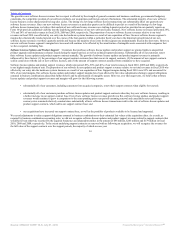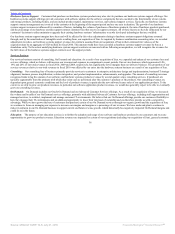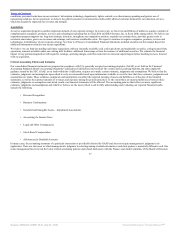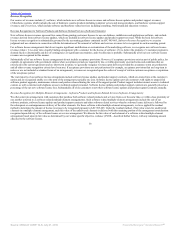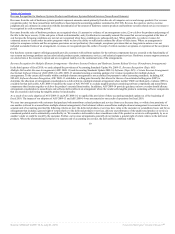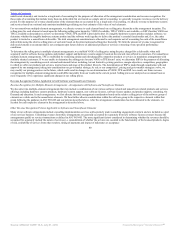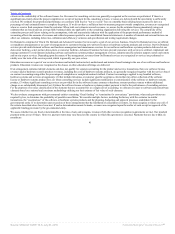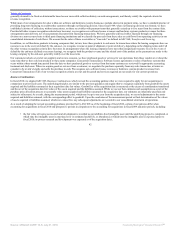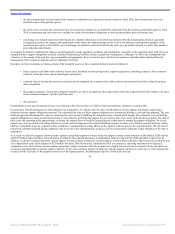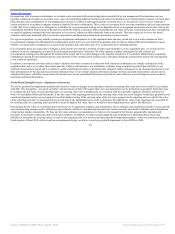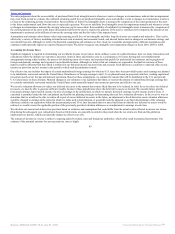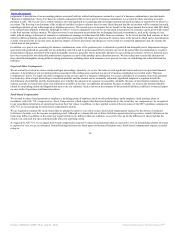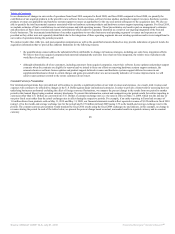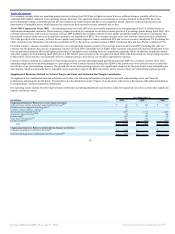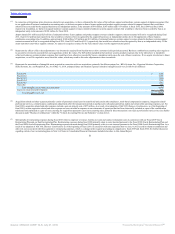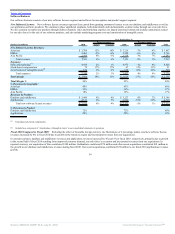Oracle 2009 Annual Report Download - page 48
Download and view the complete annual report
Please find page 48 of the 2009 Oracle annual report below. You can navigate through the pages in the report by either clicking on the pages listed below, or by using the keyword search tool below to find specific information within the annual report.
Table of Contents
In connection with a business combination, we estimate costs associated with restructuring plans committed to by our management. Restructuring costs are
typically comprised of employee severance costs, costs of consolidating duplicate facilities and contract termination costs. Restructuring expenses are based upon
plans that have been committed to by our management, but may be refined in subsequent periods. As noted above, we account for costs to exit or restructure
certain activities of an acquired company separately from the business combination. These costs are accounted for as one-time termination and exit costs pursuant
to ASC 420, Exit or Disposal Cost Obligations. A liability for a cost associated with an exit or disposal activity is recognized and measured at its fair value in our
consolidated statement of operations in the period in which the liability is incurred. When estimating the fair value of facility restructuring activities, assumptions
are applied regarding estimated sub-lease payments to be received, which can differ materially from actual results. This may require us to revise our initial
estimates which may materially affect our results of operations and financial position in the period the revision is made.
For a given acquisition, we may identify certain pre-acquisition contingencies as of the acquisition date and may extend our review and evaluation of these
pre-acquisition contingencies throughout the measurement period (up to one year from the acquisition date) in order to obtain sufficient information to assess
whether we include these contingencies as a part of the purchase price allocation and, if so, to determine their estimated amounts.
If we determine that a pre-acquisition contingency (non-income tax related) is probable in nature and estimable as of the acquisition date, we record our best
estimate for such a contingency as a part of the preliminary purchase price allocation. We often continue to gather information for and evaluate our
pre-acquisition contingencies throughout the measurement period and if we make changes to the amounts recorded or if we identify additional pre-acquisition
contingencies during the measurement period, such amounts will be included in the purchase price allocation during the measurement period and, subsequently,
in our results of operations.
In addition, uncertain tax positions and tax related valuation allowances assumed in connection with a business combination are initially estimated as of the
acquisition date and we reevaluate these items quarterly with any adjustments to our preliminary estimates being recorded to goodwill provided that we are
within the measurement period and we continue to collect information in order to determine their estimated values. Subsequent to the measurement period or our
final determination of the uncertain tax positions estimated value or tax related valuation allowances, changes to these uncertain tax positions’ and tax related
valuation allowances will affect our provision for income taxes in our consolidated statement of operations and could have a material impact on our results of
operations and financial position.
Goodwill and Intangible Assets—Impairment Assessments
We review goodwill for impairment annually and whenever events or changes in circumstances indicate its carrying value may not be recoverable in accordance
with ASC 350, Intangibles—Goodwill and Other. The provisions of ASC 350 require that a two-step impairment test be performed on goodwill. In the first step,
we compare the fair value of each reporting unit to its carrying value. Our reporting units are consistent with the reportable segments identified in Note16 of
Notes to Consolidated Financial Statements. If the fair value of the reporting unit exceeds the carrying value of the net assets assigned to that unit, goodwill is not
considered impaired and we are not required to perform further testing. If the carrying value of the net assets assigned to the reporting unit exceeds the fair value
of the reporting unit, then we must perform the second step of the impairment test in order to determine the implied fair value of the reporting unit’s goodwill. If
the carrying value of a reporting unit’s goodwill exceeds its implied fair value, then we would record an impairment loss equal to the difference.
Determining the fair value of a reporting unit involves the use of significant estimates and assumptions. These estimates and assumptions include revenue growth
rates and operating margins used to calculate projected future cash flows, risk-adjusted discount rates, future economic and market conditions and determination
of appropriate market comparables. We base our fair value estimates on assumptions we believe to be reasonable but that are unpredictable and inherently
uncertain. Actual future results may differ from those estimates. In addition, we make certain judgments and assumptions in allocating shared assets and
liabilities to determine the carrying values for each of our reporting units. Our most recent annual goodwill impairment analysis, which was performed during the
fourth quarter of fiscal 2010, did not result in an impairment charge, nor did we record any goodwill impairment in fiscal 2009 or 2008.
44
Source: ORACLE CORP, 10-K, July 01, 2010 Powered by Morningstar® Document Research℠


